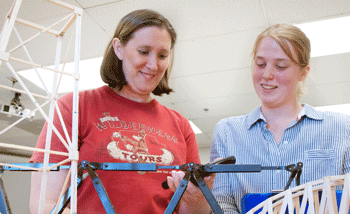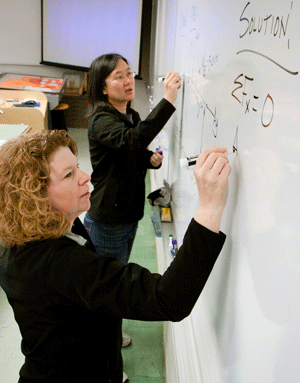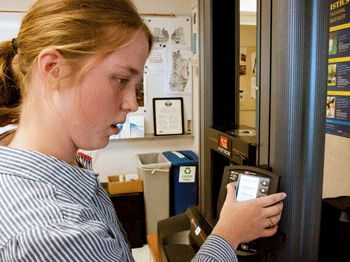Clark’s Stem Programs Inspire Women
Supportive clubs and mentors draw women into high-demand fields
New STEM building coming in 2016
10 instructional classrooms
11 laboratories
Study areas and offices for life and physical science divisions and engineering
$38 million in state funding for design and construction
Think for a moment how many male engineers, chemists, mathematicians, computer engineers or network administrators you know or have crossed paths with in your life. Now picture the number of women you’ve known to hold those jobs.
Walk down the aisles of your local toy store marked with pink signage. What do you see? Dolls, fashion accessories and cooking. Next door in the blue- and orange-colored aisles are LEGOs, trucks and math games.
The discrepancy between male and female role models and toys that shape learning, speaks volumes to girls, say Clark College professors.
Reinforcing the social stereotypes are parents, teachers and other adults who dissuade—either subtlety or directly—girls from pursuing their interests in science, technology, engineering or math (STEM).
“My parents believed that women should only be teachers or nurses,” said Debbie Peters, a Clark engineering student. “So I worked in elementary education for about six years, but I was not happy with my life.”
With degrees in sociology and biology already in hand, Peters, 36, has an educational foundation that is helping her dive deeper into her physics and calculus courses this quarter.

Left to right, STEM students Debbie Peters and Audreyana Foster design a bridge.
Peters is in a unique group. Look into a physics, engineering or other science classroom at any American college, and you’ll likely see far fewer women than men. In 2009, women received 18 percent of the bachelor’s degrees in science and engineering and computer sciences, 42 percent in physical sciences, 43 percent in mathematics and 58 percent in biological/agricultural sciences, according to the National Science Foundation’s National Center for Science and Engineering Statistics.
Clark College mirrors that trend. The seats in physics classes are 75 percent filled by men. The ratio in Clark’s engineering courses is 10 to 1, men to women, according to college data. However, there are more women than men taking courses in chemistry, geology and mathematics during the 2011-2012 academic year.
The college’s STEM unit contains programs in biology, chemistry, physics, geology, math, surveying, computer-aided design and drafting, engineering and computer science.
But what may set Clark apart is the balance of female STEM professors and those in leadership positions compared to their male counterparts, according to Tina Barsotti, Clark’s engineering division chair.
Students are keenly aware of this.
“Little girls don’t see women being chemists or engineers,” said Peters, adding that women tend to follow the biology field because they see women as doctors, nurses and other health care professionals.

Left to right, engineering professors Tina Barsotti and Carol Hsu.
A cultural thing
Students at Clark have role models in the STEM faculty. There are three STEM division chairs—all are women; Kristine Barker, mathematics; Rebecca Martin, biology; and Barsotti, engineering. Of the 11 STEM departments, five leadership roles are held by women, three by men. The dean of STEM is a man, Peter Williams. The full-time professor ratios are balanced with 23 women and 22 men.
Clark has made a concerted effort to hire female STEM faculty and put them in leadership positions. But finding those women in the marketplace can be difficult. Studies show that women have made significant advancements in law, medicine and business over the last half a century, but they continue to lag behind men in engineering, physics and computer science, according to a 2008 American Association of University Women (AAUW) report “Why So Few? Women in Science, Technology, Engineering and Mathematics.”
Why are there so few women graduating from STEM programs? The reason is multi-faceted, but some of Clark’s STEM female faculty said there are drivers such as an American culture that promotes women and girls as consumers or caretakers, instead of problem solvers or inventors. Moreover, mainstream media and retailers perpetuate the myth by glamourizing and endorsing passive products for girls.
[quote style=”boxed”]“Clark is currently assessing what is needed in a new STEM building to meet the workforce needs of Southwest Washington. Once decided, we will turn to the community for their support to augment state funding so that we can train future engineers, network administrators and other professionals for STEM jobs in the region.” ~ Ara Serjoie, senior vice president, Clark College Foundation[/quote]“The types of toys we make available to our children help shape the set of skills they’ll develop and their interests,” said Nicoleta Sharp, Clark’s only full-time, tenured female physics professor. Sharp is one of three women in an overall department of 12 professors and instructors.
Sharp, who studied in Romania and France, said the cultural forces that undermine women and girls’ aspirations in STEM are characteristic of the United States and not something she sees in Europe.
“The entire society looks surprised when a woman does science work here,” she said, adding, “From my experience, the percentage of female students in STEM disciplines in Europe is about 40 percent, versus 60 percent male. The STEM fields are perceived as being equally accessible to men and women, and women are expected to succeed in STEM professions at the same rate as their male counterparts.”
NERD girls
Clark College’s approach to bridging the gender divide and cultivating women and girls’ interest in and tenacity with STEM is by being role models, holding networking events and creating a buzz about groups and activities.
One such group is the Not Even Remotely Dorky (NERD) Girls club. Among its many roles, the group visits K-12 area schools offering hands-on challenges and demonstrating that science is fun.
“It is run by women, directed by women and focuses on what they want to do,” said Barsotti, adding, “It’s made a world of difference in the women’s sense of community.” And despite the name, NERD Girls is open to men at Clark too.
Audreyana Foster, 17, is a Running Start student at Clark and the president of NERD Girls. She loves teaming up with children at a local elementary school because “we break the stereotypes that STEM is not a place for girls.”
The club members say they have fun figuring out how stuff works or devising ways to construct a building out of uncooked spaghetti, tape and a marshmallow peak.
“NERD Girls makes school easier because we’re laughing and experiencing teamwork,” said Foster, referring to working with young children and collaborating with other Clark NERD Girls.

Audreyana Foster
Socializing
Studies show that women and girls become more engaged and are more likely to stay in the STEM fields when there is a supportive social environment, according to AAUW. Clark offers a tea social to connect students with female faculty and learn first-hand how faculty members balance their personal and professional lives.
The college also holds regional and statewide Science Olympiad events on campus that give students a chance to test their creative and problem-solving skills.
Furthermore, a Women in STEM Math Help Center is a drop-in resource that is staffed by female instructors or professors and open to women and men.
“Women learn best when they work together with other women,” said Kristine Barker, Clark’s mathematics department chair. She said older women tend to frequent the help center the most. “They find it a supportive environment. It’s very well attended.”
Keeping STEM fun and engaging, while limiting negative stereotypes—such as the misnomer that boys are better than girls in mathematics—is key to unlocking female curiosity and keeping them on the STEM track, according to AAUW.
“If we lose them at 8th grade, we’re never going to see them to tell them how cool science and math are,” said Carol Hsu, Clark engineering professor.
Build and they will come
Dean Williams said access to modern facilities is paramount to attracting and retaining students—women and men—to Clark’s STEM programs.
“We don’t have enough lab space to fulfill our students’ needs,” he said. It’s critical, he adds, that students have access to modern equipment and learning tools in order to prepare them for today’s competitive and highly skilled workforce.
Southwest Washington is expected to have 650 STEM-related job openings over the next decade, according to Scott Bailey, regional economist with the Washington Employment Security Department. Some of the occupations with the highest demand include computer software engineers and networking, as well as civil, electrical and mechanical engineers, and medical scientists.
Clark is poised to be a regional leader in educating STEM employees with the construction of a modern 70,000-square-foot facility that is slated to begin in 2014.
When completed, the center will serve in partnership with industry and other educational institutions to foster exploration, interactive learning and innovative teaching techniques for women and men, according to Clark officials.

